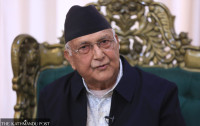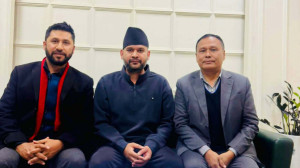Politics
Could the rise of Rastriya Swatantra Party boost anti-federal forces?
Rabi Lamichhane and Balen Shah deliberately skipped voting for provincial candidates, to the delight of federalism sceptics.
Prithvi Man Shrestha
The newly formed Rastriya Swatantra Party, which is doing rather well in the federal elections based on votes secured in the early stages of vote-counting, didn’t field candidates in provincial elections.
In the November 20 vote, its president, Rabi Lamichhane, was seen skipping voting for provincial candidates in a widely circulated video. When asked why he chose not to vote for province-level candidates, Lamichhane responded that his party was not participating in provincial elections and that he has reservations over the current provincial setup.
“We decided not to participate in provincial elections. We don’t have election symbols [in provincial ballot papers]... we want improvements in the current provincial structure. We have not talked about scrapping the provincial structure,” said Lamichhane. “I used my right to express our reservations over the current structure.”
Lamichhane is not the only next-generation leader with reservations over the current provincial setup. Balen Shah, mayor of the Kathmandu Metropolitan City, was also seen avoiding casting votes for provincial candidates. After Shah cast his vote in federal elections, the police personnel present at the polling booth appeared to have asked him to also vote for provincial assembly candidates. He ignored the call.
Under the current federal structure, provinces are one of three tiers of the government. As the central and local governments were already present in the old constitutional setup, provinces were the only new structures. Nepal has adopted a cooperative model of federalism where the three tiers of government are supposed to function in harmony. Under this model, the federal government acts as a facilitator in relations between provinces and has the authority to prepare an umbrella law to implement federalism.
The refusal of Lamichanne and Shah to endorse the provincial setup has raised a question over their commitment to the country’s federal system which came into existence after the country adopted the new constitution in September 2015. It has also made people wonder about the size of the anti-federalism constituency in Nepal.
Earlier, the Rastiya Janamorcha led by Chitra Bahadur KC, a fringe leftist party, was the only political force explicitly speaking against federalism.
Lal Babu Raut, chief minister of Madhesh Province, believes efforts are afoot to undermine the federal system. “A new party needs a new agenda to prove its relevance, so its position against the current federal set-up should be seen in that light,” said Raut referring to the Rastriya Swatantra Party.
“Not only in this new party, there are also elements in established parties including the Nepali Congress, the UML and the CPN (Maoist Centre) that are against federalism, which they think is an expensive experiment.”
Mukul Dhakal, general secretary of the Rastriya Swatantra Party, said his party was not against federalism. “We just want a different, more viable model of federalism,” he said.
The new party, which is expected to emerge as a force to be reckoned with after the latest elections, has expressed its reservations with the current federal setup in its election manifesto, although it has not challenged the federal system outright.
As per the party manifesto, power continues to be concentrated at the centre while jumbo provincial assemblies are creating a huge financial burden on the state. Different regions need different provincial structures. Similarly, different numbers and types of ministries are needed for different areas, its manifesto states.
Dhakal said his party envisions a provincial setup with no provincial assemblies that are otherwise sucking in huge amounts of money.
The seven provincial assemblies have double the members of the House of Representatives. The House of Representatives has 275 members while seven provincial assemblies have 550 members.
“As per our vision, the provincial executives will be elected through the first-past-the-post electoral system,” Dhakal said. “A provincial council represented by certain elected representatives of local governments will modify the laws to make them compatible for the provinces. The provincial executives will be accountable to the council.”
Dhakal said such a structure would not only make the provinces powerful but also less expensive. However, such changes are possible only through an amendment to the existing constitution, which is not easy: any amendment should be passed by a two-thirds majority.
Chief Minister Raut, who is also the leader of the Janata Samajbadi Party, believes that anti-federalist forces have been trying to discredit the federal setup by talking up its ‘high cost’. “There are forces who also say that a small country like Nepal cannot afford ‘expensive’ federalism,” he said.
In the fiscal year 2020-21, recurrent expenditure (administrative expenditure) of the provincial government stood at Rs75.37 billion, according to Consolidated Financial Statement-2020-21 published by the Financial Comptroller General Office.
Recurrent expenditure of the seven provincial governments is far lower than that of the federal and the local governments, as the latter two spent as much as Rs846 billion and Rs235 billion respectively, according to the report.
Government services have been brought to people’s doorsteps by provincial governments, which, otherwise, would not have been possible, Raut argued.
“As provinces are new creations, they might have some shortcomings. You cannot expect a child to run against grownups and still win the race,” said Raut, adding that the provinces were being forced to work with limited staff.
He believes that with the Provincial Public Service Commission starting to recruit staff, there would be more competent and dedicated government employees in the provinces but this is something that takes time.
According to Raut, service delivery of provincial governments was also affected due to frequent changes of senior bureaucrats as per the decisions of the central government. “For example, there were seven principal secretaries in our Madhesh province in the past five years, and the secretaries in our ministries were changed a dozen times,” he said.
Experts say provinces have been weaker compared to central and local governments as they are not entitled to collect many resources. The central government has also been accused of infringing upon the constitutional authority of the provincial governments.
Since August 2019, the Madhesh Province has filed at least six petitions at the Supreme Court, claiming that the federal government was encroaching on the provinces’ jurisdictions, against the spirit of the constitution.
However, except for issuing interim orders on some petitions, the court is yet to conduct a final hearing on any of the cases.
Dipendra Jha, who resigned in September from the position of chief attorney of the province, had told the Post in early August that the foundation for a full-fledged functioning of the provinces would have been set up had the Supreme Court settled those petitions. “Efforts were made to handicap provincial governments by infringing upon their jurisdictions, giving anti-federalism forces an excuse to blame the provincial government as worthless,” said Raut.
In a report, the Public Expenditure Review Commission 2019 states that the federal government has unnecessarily entered the jurisdiction of the provincial and local governments. The report also includes details about a number of federal government departments operating in the jurisdiction of the sub-national governments.
According to the report, the central government was found to have changed the names of certain institutions and projects with the aim of not sending the staff and resources to the provincial and local levels. Areas of work were added in the case of certain programmes to keep them under inter-provincial jurisdiction, so that central authority could intervene, the report states.
Despite promising to send more government employees at local and provincial levels, the federal government had kept most of its staff at the centre, forcing the sub-national government to make do with limited staff for several years.
Former chief secretary Som Lal Subedi said the provinces have struggled to carry out their duties as their space has been constrained by the federal and local governments. “The provinces started working from zero, and they were asked to work in an unfavourable environment. The provinces for instance have no strong revenue base,” said Subedi, who is an expert on federalism.
“Without offering any help, how could the current federal structure properly function and how can the relevance of the province be questioned?” Subedi asked.




 15.28°C Kathmandu
15.28°C Kathmandu















